21 Frequently Asked Questions About Feeding Hummingbirds
Updated: Jan. 25, 2024
Get answers to your most commonly asked questions about feeding hummingbirds and hummingbird behavior from birding experts.
On This Page
Questions About Feeding Hummingbirds
Hummingbirds are amazing creatures, with the ability to fly backward using wings that beat about 30 times a second. It’s no wonder people love attracting hummingbirds to their yards to enjoy them up close. Birding experts Kenn and Kimberly Kaufman answer some of your most frequently asked questions about feeding hummingbirds.
What’s the Recipe for Sugar Water to Feed Hummingbirds?
Mix four parts hot water to one part sugar. While some people don’t boil their water, it’s best to boil and then let it cool to room temperature to remove any impurities. Be sure to change out the sugar water every few days. You can store extra sugar water in your refrigerator for a week or more.
Should I Add Red Food Coloring to the Mixture?
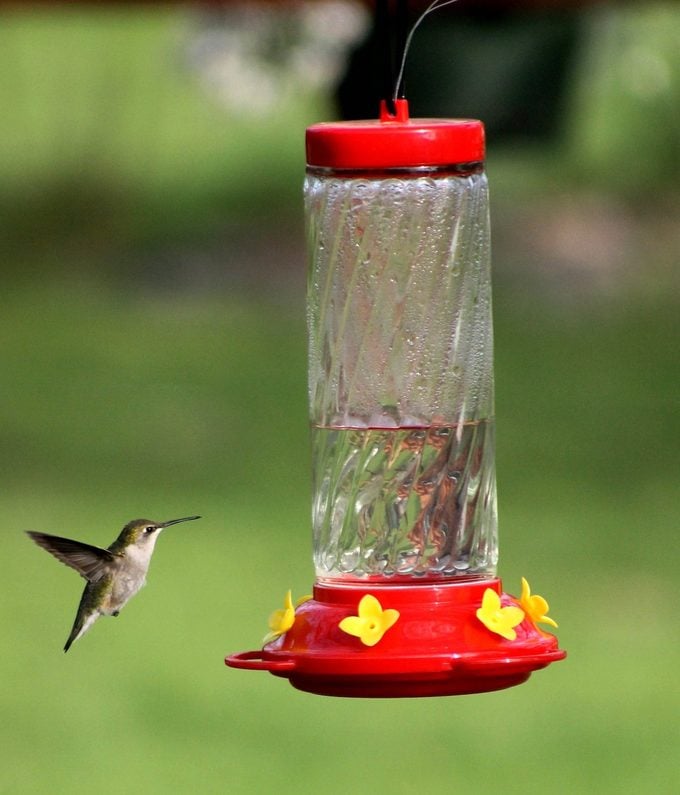
One of the older red food colorings was found to be toxic to birds, but with the new formulations, I don’t believe that’s still true. However, it isn’t necessary to add red dye or other ingredients to feed hummingbirds. The feeders usually have red parts, which provide enough color to attract hummingbirds. Stick to clear sugar water when feeding hummingbirds. You should steer clear of brown sugar, powdered sugar, honey and any other ingredient but plain white sugar.
Check out the best red hummingbird flowers to grow.
Is Organic Sugar Better for Hummingbird Feeders?
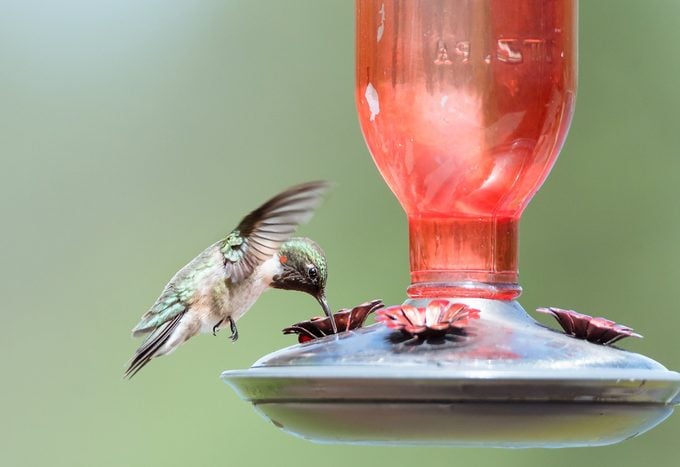
Pure white table sugar is the safest option for mixing nectar for hummingbirds. Many consider organic sugar, which doesn’t tend to be fully refined to pure sucrose, unsafe for feeding birds.
How Can I Prevent Mold Growth in Hummingbird Feeders?
“How do you keep homemade hummingbird nectar from getting moldy?” writes Birds & Blooms reader Della Lansdell of Prattville, Alabama.
We suggest mixing your own hummingbird sugar water, using 4 parts water to 1 part sugar, and bringing it to a full boil to break down the sugar completely. Once it’s cool, refrigerate what you don’t use between fillings. Avoid using red dye; the birds don’t need it, and it’s easier to monitor the freshness of colorless sugar water. Another way to avoid mold is to fill feeders only halfway and clean them before each refill. Placing your feeders in the shade will also help keep sugar water from spoiling too quickly.
What Are the Best Feeders for Hummingbirds?
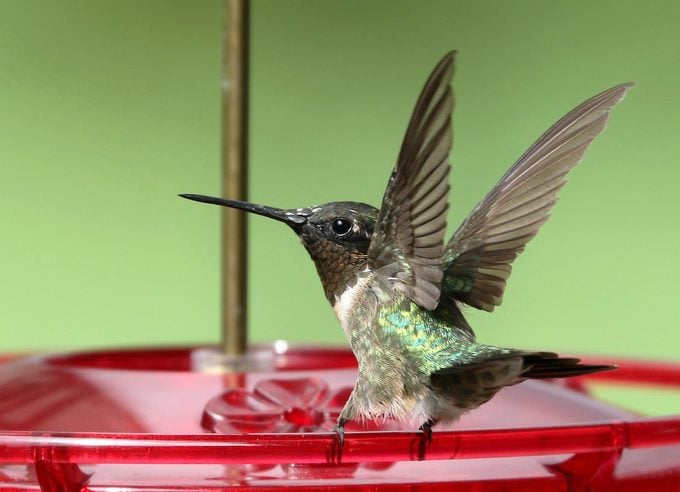
For the most part, hummingbirds aren’t picky, so the best feeder is the one you find easiest to fill, clean and hang. The traditional glass bottle that threads into a plastic basin works extremely well. We prefer the 30-ounce bottle because it’s more stable and doesn’t tip as easily when orioles drink from it. We also like the type with a shallow plastic basin where the lid with feeding ports snaps down over it. Both are easy to clean, and that is important.
Learn how to clean hummingbird feeders.
When Should I Hang My Hummingbird Feeders?
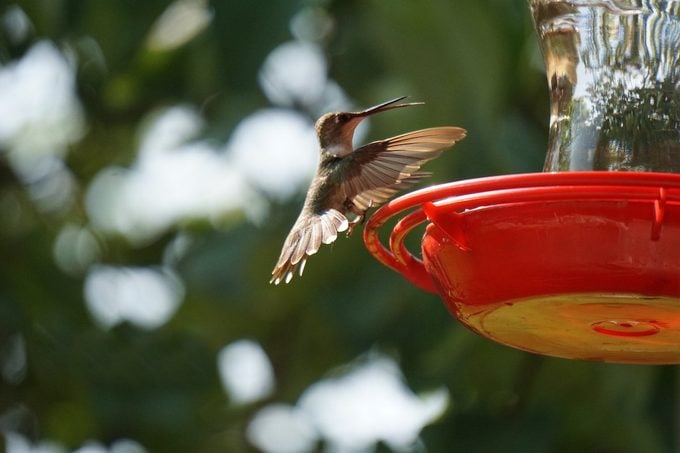
Early May is a good time to hang up your hummingbird feeders. In the South, migratory hummingbirds begin tapping sugar water feeders in backyards in early April. The funny thing about it is that if you don’t get them up early enough, the hummingbirds will often remind you by returning to the spot where the feeders were last summer and hover there looking for them.
Where Should I Hang Hummingbird Feeders?
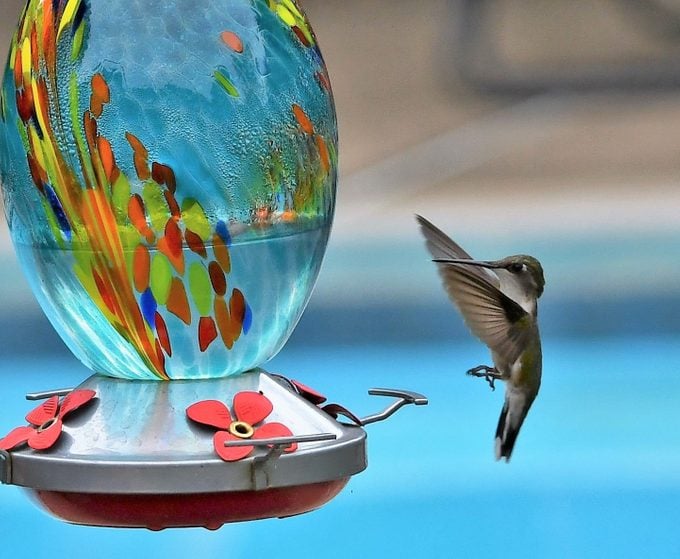
Since they’re accustomed to hovering low in front of flowers, there’s no real height requirement for hummingbird feeders. Just make sure the feeder is in a place where it’s easy to see and enjoy! This will allow you to monitor it closely for filling and cleaning, too.
Are Hummingbirds Territorial at Feeders?
“I never get more than one hummingbird at a time at my feeders. How can I encourage them to share?” asks reader Cheryl Vandermark of Wallkill, New York.
Hummingbirds have an instinct to protect their food sources, because in nature, a patch of flowers will produce only so much nectar in a day. The tiny birds carry this defensiveness over to artificial feeders. The best way to keep one hummingbird from dominating a feeder is to put up several feeders in different spots. If some feeders can be out of sight from the others (around a corner, for example), it will be even harder for one bird to control them all. With multiple feeders available, even the most aggressive hummingbirds may give up and just share with others.
Do fighting hummingbirds ever hurt each other?
I’ve Planted a Hummingbird Garden, but Why Don’t They Visit?
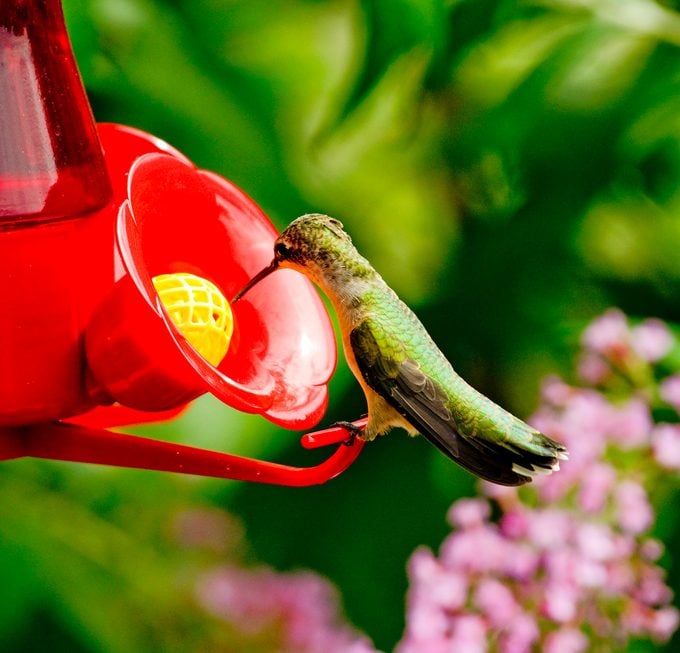
Try placing a hummingbird nectar feeder close to or among the colorful hummingbird flowers in your garden. This should create a target area for the birds and make attracting hummingbirds to your garden much easier.
Is It Better to Plant Flowers for Feeding Hummingbirds?
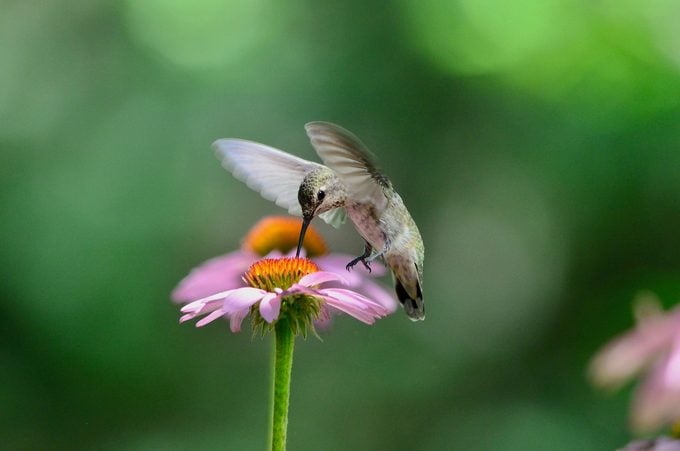
If we had to choose one over the other, we’d vote for planting flowers because they have many other benefits. A flower garden with a focus on native plants, full of a variety of species chosen to bloom throughout the warmer months, will sustain butterflies, bees and other pollinators. The tiny insects feeding on the plants’ leaves will in turn feed warblers and other songbirds.
But we think it’s ideal to have both flowers and feeders. A sugar-water feeder can be placed where it’s easy to watch, and it can help keep hummingbirds faithful to the yard during lulls in the garden’s blooming activity.
Learn how to attract hummingbirds to your small garden.
Will Hummingbirds Become Dependent on Feeders?
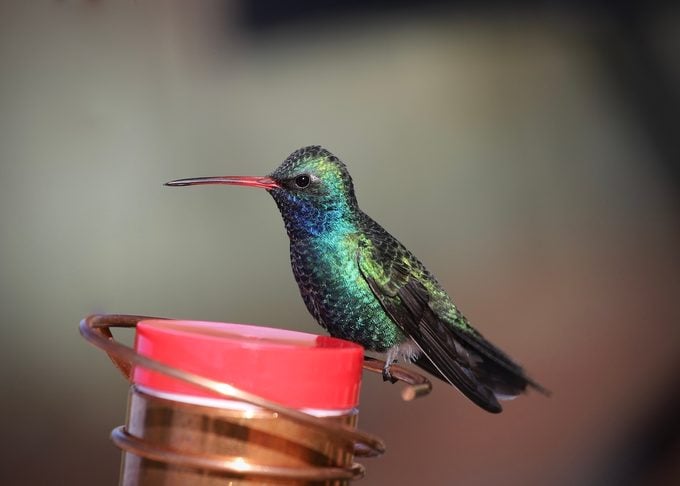
“We’re selling our house, and I’m concerned the new owners will not keep the hummingbird feeders filled. What will happen?” says reader Vincent Staley of Fredericksburg, Virginia.
We appreciate your concern, but hummingbirds are adaptable and good at finding new places to live. In natural habitats, good concentrations of flowers may change over time. For example, a meadow filled with flowers one year may be overgrown with shrubs the next. Hummingbirds have to be able to move around and find new food sources. Of course, if you can talk to the new residents of your home, you could try to inspire them with stories about feeding hummingbirds and tell them the rewards of keeping the feeders filled and clean.
Here’s how to create an ideal hummingbird habitat.
How Can I Keep Yellow Jackets Off Hummingbird Feeders?
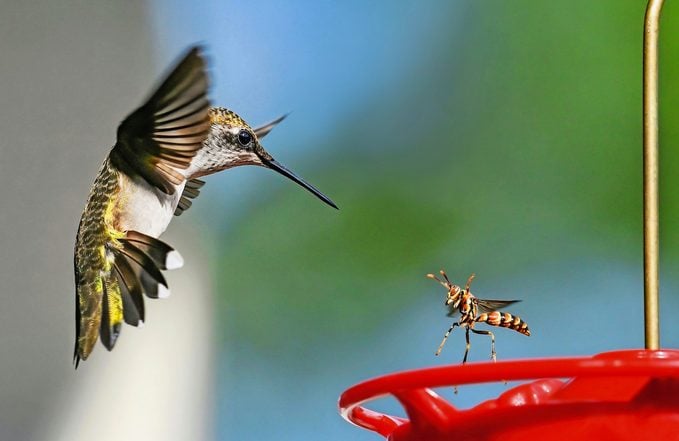
“How can I keep yellow jackets away from my hummingbird feeders? asks reader Gail Mitchell of Martinsville, Virginia.
Reducing the ratio of sugar to water might help. Try 5 parts water to 1 part sugar, instead of the usual 4 to 1. Be sure to clean any spillage off the feeding ports. Since bees and wasps prefer to feed in sunny areas, you could try moving your feeders to a shadier area. Avoid using products such as pesticides, petroleum jelly or cooking oil on the feeding ports to discourage bees and wasps, since these substances can be deadly for hummingbirds. It’s also good to remember that these insects are important pollinators, and we should protect them, too.
Check out more natural ways to keep wasps away from hummingbird feeders.
Do Bees Make Hummingbird Feeders Dirtier?
“I have several sugar-water hummingbird feeders. Bees invade some of them. When I bring in the feeders for cleaning and refilling, the ones used by bees are usually dirtier. Why?” asks reader Ellen Gonzales of Dripping Springs, Texas.
It’s hard for us to be sure without actually seeing the feeders involved, but we have some ideas. Bees only visit feeders where the sugar water is easy to reach—especially if it’s leaking or spilled on the outside. Even a very slow leak can make the feeders dirtier inside and out. Bees often carry pollen, and they may leave a light dusting of it on every visit to the feeder, adding to the mess. Check your feeders carefully for leaks, install bee guards on the openings, and consider switching to the dish feeder style in which the openings are raised well above the level of the sugar water.
Use an ant moat to keep ants off of your hummingbird feeders.
How Do Hummingbirds Feed Their Babies?
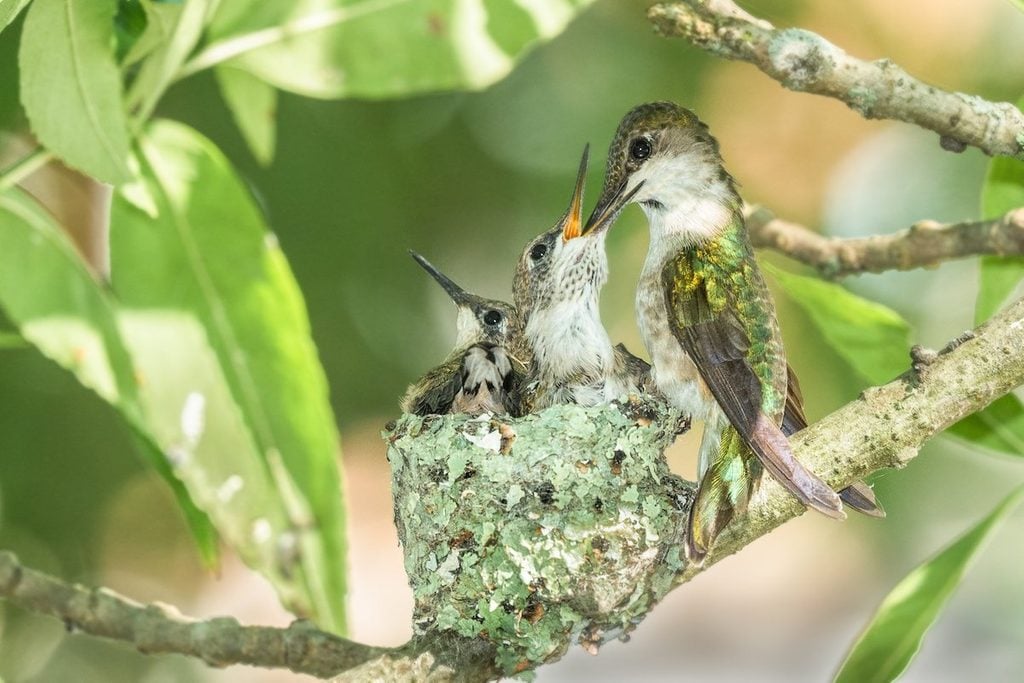
Hummingbirds usually feed tiny insects and spiders to their young. They insert them right into the mouths of their baby hummingbirds. They’ll also feed nectar and pollen to the young birds. They do this by holding it in their throats and then squirting it into the mouth of the nestlings. Sometimes this will cause the youngster’s throat to swell temporarily, resembling a goiter.
Here’s everything you need to know about hummingbird nests.
How Do Hummingbirds Drink Nectar?
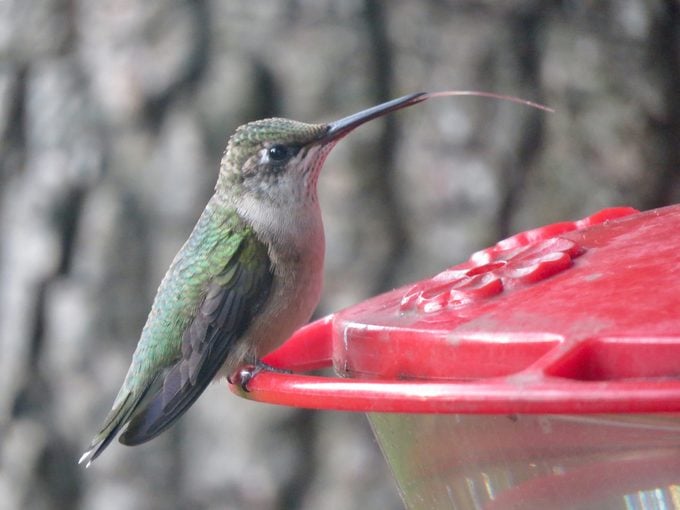
This is a bit of a tricky one. Hummingbirds seem to use their tongues in a way that scientists never expected —a hummingbird tongue’s tubes open down their sides when they insert it into a flower or feeder. When they pull the tongue back in, the tubes zip closed around the nectar, bringing it back into the bird’s mouth. They are one of the few species of birds that swallow liquid without throwing their head back to allow gravity to help them swallow.
Hummingbird sounds: do hummingbirds sing?
I Saw a Yellowish Hummingbird at My Feeder. Is This Common?
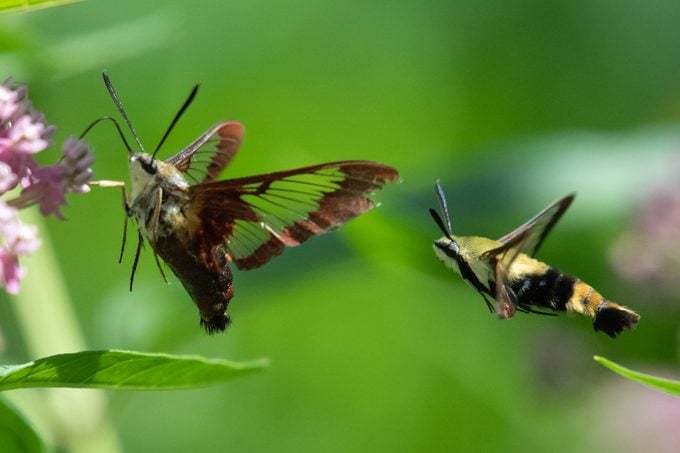
Though rare, some bird species will produce a yellow version of themselves, such as yellow cardinals. This condition is called xanthochroism, an abnormal yellowing of the plumage. It is thought to be caused by a loss of dark pigment (melanin) in the bird’s feathers. If the mystery visitor was much smaller than a hummingbird, it could be a sphinx moth, also called a hummingbird moth. This is a diurnal moth (meaning it’s out during daylight), and one variety is yellow in color and common in gardens in the summer.
What makes hummingbird feathers so shimmery?
Why Do Hummingbirds Hang Upside-Down From Feeders?
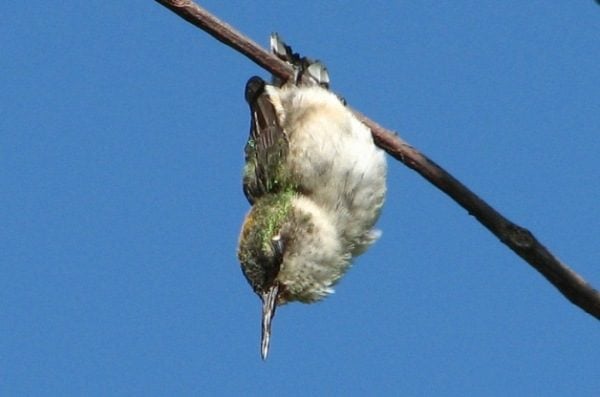
“I saw a hummingbird hanging upside down from my sugar-water feeder by one foot. As I neared, it flew away. What happened to it?” says reader Margaret Hocker of Metropolis, Illinois.
Hummingbirds have a bizarre way of conserving energy. Usually at night, during periods of cold and sometimes when they’re perched at a feeder, hummingbirds can enter a deep, sleep-like state known as torpor, when all body functions slow dramatically. Metabolism slows by as much as 95%, and heart rate and body temperature drop significantly. Torpor allows them to conserve precious energy and survive surprisingly low temperatures. Hummingbirds are tough birds! If you see a hummingbird in such a state, there is no cause for concern.
Where do hummingbirds sleep at night?
Why Do I Never See Male Hummingbirds at My Feeders?
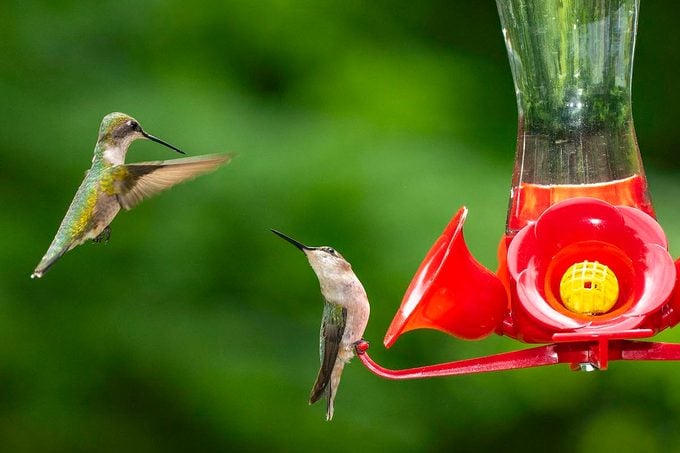
“I only have female ruby-throated hummingbirds visiting my sugar-water feeder and the flowers on my deck rail. I never see males. Do they like different flowers and the types of feeders than the females? asks reader Linda Anderson of Berwick, Pennsylvania.
Males and females generally like the same things, so there may be other factors at work here. It’s possible that the male hummingbirds in your area have territories away from your feeders and flowers so you don’t see them as often. We’ve also seen females defending the territory around the nest, actively chasing off the males and other females that venture too close. Also, remember that juvenile hummingbirds (both males and females) look like the adult females, so they outnumber the flashy ruby-throated adult males.
How Can I Help Hummingbirds Fuel Up for Migration?
Hummingbirds store enough fat to allow them to cross the Gulf of Mexico. In fact, they begin this storage before they even leave their nesting grounds. You may notice that in late summer, just before they begin to migrate south, hummingbird behavior changes a bit and they eat more food more often. They stop to feed along the way, too, and store as much energy as possible. That’s why it’s important to maintain sugar water feeders at least through September, even after hummingbird activity subsides.
Add a bird bath for hummingbirds to your yard.
Why Do Finches Visit Hummingbird Feeders?
“Is it normal for house finches to drink sugar water?” writes reader Shannan Shade of Marshall, Wisconsin.
Although hummingbirds are the only true nectar specialists in North America, many birds sample the sweet stuff when they get the chance. Once they learn to drink from hummingbird feeders, house finches may become regular visitors. Other examples of surprising visitors include titmice, several warblers (including Cape May, pine and orange-crowned), goldfinches, mockingbirds, chickadees, and thrashers. Aside from birds, your sugar water feeders also may attract nectar-feeding bats (in the Southwest), squirrels, and even bears if there happen to be any in your neighborhood.
Is that a woodpecker at a hummingbird feeder?
How Can I Keep Orioles Away from Hummingbird Feeders?
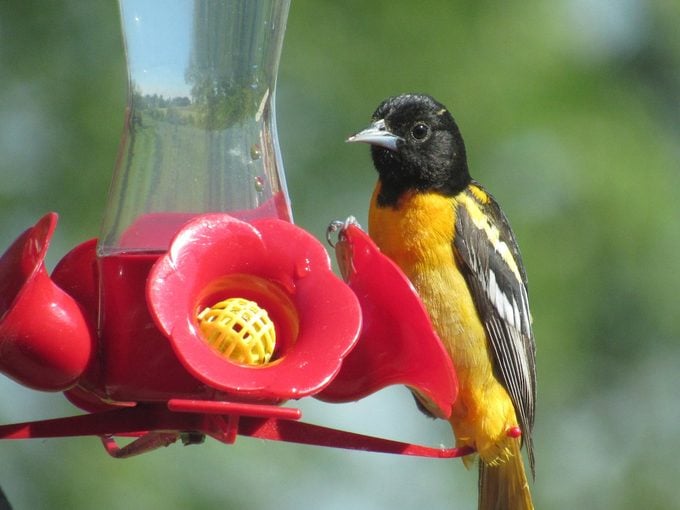
“How can I keep larger birds like orioles from monopolizing my hummingbird feeders?” says Roger Hatfield of Del Rio, Texas.
In your region of Texas, you’re lucky to have several types of orioles, but we understand why you’d want to keep space open for feeding hummingbirds. One approach is to have one or two “sacrificial” feeders, with perches that make it easy for orioles and other larger birds to drink sugar water. If you have other feeders with no perches, the hummingbirds can still hover at those to feed, ideally undisturbed by the larger birds.
Contributing writer and birding expert: George Harrison
Why Trust Us
For nearly 30 years, Birds & Blooms, a Trusted Media Brand, has been inspiring readers to have a lifelong love of birding, gardening and nature. We are the #1 bird and garden magazine in North America and a trusted online resource for over 15 million outdoor enthusiasts annually. Our library of thousands of informative articles and how-tos has been written by trusted journalists and fact-checked by bird and garden experts for accuracy. In addition to our staff of experienced gardeners and bird-watchers, we hire individuals who have years of education and hands-on experience with birding, bird feeding, gardening, butterflies, bugs and more. Learn more about Birds & Blooms, our field editor program, and our submission guidelines.
